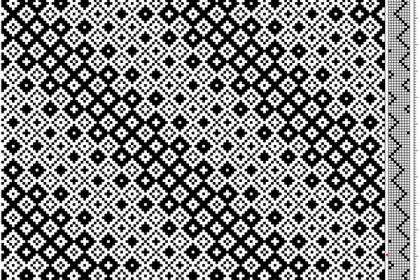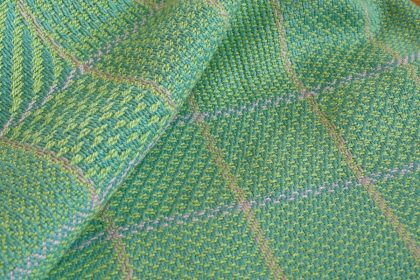We’ve established that there are lots of ways to vary the tie-up when you’re weaving a twill on 8 shafts. Now we can add to that variety by exploring different threadings too. In an earlier post I looked at twill blocks, where each group of 4 shafts is treated as an independent unit in the design. Here we will focus on threadings which stretch over all 8 shafts, expanding the scale of the twill.
The Basics
First of all, we can always rely on our two staple threadings: the straight draw and the point draw. In fact, these can not only be stretched from 4 to 8 shafts, but to any number of shafts we have available.


The point draw on this scale is quite exciting as it allows us to design larger symmetrical motifs, but there is a hazard to look out for. If we were to use some of the more extreme tie-ups we looked at earlier, such as the 6/2 tie-up, we could end up with some very long floats indeed.
So our design process needs to balance both aesthetic and practical considerations to make sure that we achieve the cloth we really want.
Extending the Point
As on 4 shafts, we can extend the point draw even further, by wrapping it around so that shaft 1 follows shaft 8. We can do this symmetrically…
…or we can do it asymmetrically, by continuing one ‘leg’ of the point further than the other, e.g.
These kinds of extensions of the point draw are the basis of many well-established twill patterns such as Ms & Ws.
Advance!
As well as extending a twill, we can advance a twill. This means starting with a basic unit, which is usually a short straight run or a point. We then repeat that unit, but with each repeat we move it up one shaft.
For instance, we might start with this point over 5, which begins on and returns to shaft 1:
The next repeat will begin on and return to shaft 2:
If we keep repeating it, eventually we will have a succession of eight points with the last one beginning and ending on shaft 8:
And we have wrapped right around to where we started: the next point in the sequence will begin and end on shaft 1.
Can you see how the same principle has been applied to this advancing straight draw?
Combining extended and advancing patterns dramatically expands our design options yet again. For example, many snowflake twills are built out of these elements.
What’s next?
In this post I have mainly zoomed right in on the threading alone. Where I have shown a complete draft it is ‘treadled as drawn in’: that is, the treadling sequence mimics the threading sequence, creating a symmetry in the drawdown. Next time I will look at the effects we can create when we vary the treadling.
First posted on weavingspace.co.uk © Cally Booker


















Your explanation is so clear. Thank you. Can’t wait for the next part to see how it all works together. Lou
Glad you’re following along! This is such a big topic, I feel as though I am nibbling an elephant… though I do think it’s one of the tastiest elephants in weaving 🙂